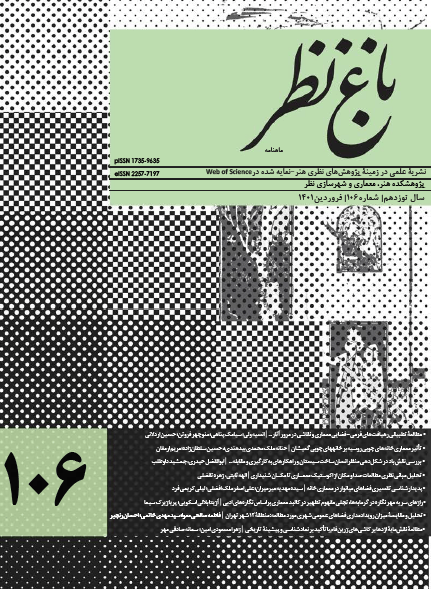نوع مقاله : مقالۀ پژوهشی
نویسندگان
- سیده مهدیه میرمیران 1
- علی اصغر ملک افضلی 2
- لیلا کریمی فرد 2
1 موسسه آموزش عالی غیردولتی آیندگان
2 استادیار گروه معماری، واحد تهران جنوب، دانشگاه آزاد اسلامی، تهران، ایران.

باغ نظر (ماهنامه)
دوره 19، شماره 106
فروردین 1401
صفحه 68-57
بیان مسئله: از گذشتههای دور دو کارکرد اصلی «دسترسی» و «دیدرسی» در فضاهای میانوار (واسط) در طراحی و ساماندهی فضا مطرح بوده است ولی امروزه در طراحی توجه چندانی به این فضاها نشده و حتی گاه نادیده انگاشته میشوند. پیامد این وضع، برآورده نشدن شماری از نیازهای روانی و معنایی است که تنها در فضاهای میانوار پاسخ مییافته و مییابند. این در حالی است که شماری از معماران پدیدارشناس بر تعامل همهجانبه گسترههای وجودی انسان با فضای معماری و اهمیت پاسخگویی به نیازهای روانی و معنایی تأکید دارند.
هدف پژوهش: این تحقیق به جستجوی کارکرد فضاهای میانوار در معماری خانه، بر پایة رویکرد چند تن از معماران پدیدارشناس معاصر میپردازد و هدف آن دستیابی به کارکرد بهینة اینگونه فضاها در خانه است.
روش پژوهش: برای رسیدن به اهداف تحقیق، در قالب روش کیفی و با بهرهگیری از رویکرد تفسیری و پدیدارشناسانه به فضا، نخست برپایة مطالعات نظری به توصیف دیدگاه چهار تن از معماران پدیدارشناس در ارتباط با فضاهای میانوار پرداخته شده است؛ سپس با بهرهگیری از روش «پدیدارشناسی تفسیری»، به ساخت واحدهای معنایی در آثارشان پرداخته شده و تواناییهای کارکردی میانوارها در دو سویة «ادراکی-معنایی»، «رفتاری-کارکردی» و نیز «ویژگیهای کالبدی-فضایی سازگار و پاسخگوی به آن کارکردها» بازخوانی شده است.
نتیجهگیری: نتایج نشان میدهند فضاهای میانوار هنگامی کارکرد بهینه دارند که بتوانند سلسله مراتب دسترسی مناسبی از فضای بیرون به درون فراهم آورند، در عین حال احساسی از آرامش و درپناهبودن را برای مخاطب فراهم آورده و همة حواس و ادراکات او را در این میان درگیر کنند. در پاسخ به این سه کارکرد ویژگیهای متمایزکنندة کالبدی همچون کاربرد نور و سایه، الگوهای صوتی، بویایی و بساوایی متفاوت و همچنین داشتن مرزهای کالبدی ویژه میتوانند پاسخگوی آنها باشند.
Interpretive Phenomenology of Interface Spaces in House Architecture
نویسندگان [English]
- سیده مهدیه mirmiran 1
- Aliasghar Malekafzali 2
- Leyla Karimifard 2
Problem statement: Two main performances, including ‘Accessibility’ and ‘Visibility’, have been proposed in (intermediate) interface spaces for design and organization since a long time ago. However, these spaces have not received much attention in design today and even they have often been ignored. As a result, psychological and intellectual requirements, which are realized in interfaces, have not to be met and responded to. In this regard, some phenomenologist architects have an emphasis on all-inclusive interaction of human’s existential ranges with architectural space and also they have emphasized the importance of responsiveness to psychological and conceptual needs.
Research objective: The present article seeks to investigate the function of interfaces in house architecture, based on the approach taken by some contemporary phenomenologist architects. This paper aims to achieve optimal performance of such spaces in houses.
Research method: To this end, it has been firstly dealt with the description of attitudes from four phenomenologist architects concerning interfaces based on theoretical studies within the qualitative methodology and benefitting from interpretive and phenomenological approach; then using ‘interpretive phenomenology’, the conceptual units were built in their works and their functional capabilities of interfaces have been revised in two perceptual-conceptual and behavioral-functional aspects as well as compatible and responsive formative-spatial features to those performances.
Conclusion: The findings show that interfaces possess optimal performance so that they are capable to provide an appropriate accessibility hierarchy of outside-to-inside space. At the same time, they may provide a sense of being calm and under shelter for the audience and they make all of his/her senses and perceptions involved among them. In response to these three functions, distinctive formative features e.g. application of light and shade with different auditory, olfactory and tactile patterns and also having specific formative boundaries may be responsive to them.
پدیدارشناسی تفسیری فضاهای میانوار در معماری خانه اصل مقاله 517.8 k
صاحب امتیاز: پژوهشکده هنر، معماری و شهرسازی نظر
مدیر مسئول: دکتر سید امیر منصوری
سردبیر: دکتر احمد پوراحمد
دوره انتشار: ماهنامه
شاپا چاپی: 1735-9635
شاپا الکترونیکی: 2251-7197




















